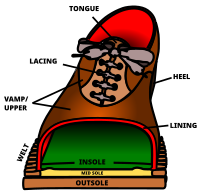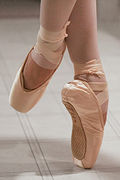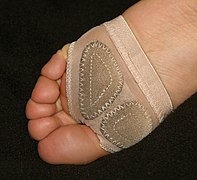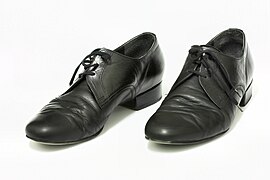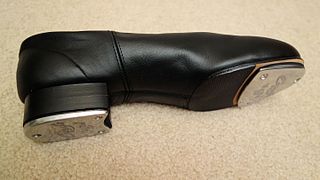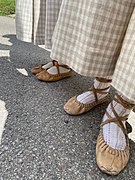Մասնակից:Մարգարյան Անուշ/Ավազարկղ14
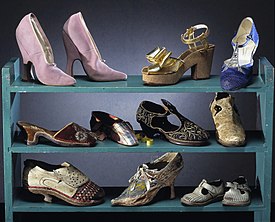
Կոշիկ, մարդու ոտքը պաշտպանելու և հարմարավետ դարձնելու համար նախատեսված հարմարանք: Չնայած մարդու ոտքը կարող է հարմարվել տարբեր լանդշաֆտներին և կլիմայական պայմաններին, բայց այն խոցելի է, և կոշիկները պաշտպանություն են ապահովում: Ի սկզբանե ձևը կապված է ֆունկցիոնալության հետ, բայց ժամանակի ընթացքում կոշիկները նաև դարձել են նորաձևության առարկա: Որոշ կոշիկներ հանդիսանում են պաշտպանիչ հանդերձանք, օրինակ ՝ պողպատե ծայրով կոշիկները, որոնք կրում են արդյունաբերական օբյեկտներում:
Բացի այդ, կոշիկները հաճախ ոճային առումով փոփոխվել են, ինչպիսիք են բարձրակրունկ կոշիկները, որոնք կանայք ամենից հաճախ կրում են նորաձևության միջոցառումների ժամանակ: Ժամանակակից կոշիկները մեծապես տարբերվոմ են ոճով, բարդությամբ և արժեքով: Բազային սանդալները բաղկացած են միայն բարակ ներբանից և պարզ ժապավենից: Հայտնի դիզայներների կոշիկները պատրաստվում են թանկարժեք նյութերից, ունեն բարդ կառուցվածք և վաճառվում են մեծ գումարներով: Կոշիկի որոշ տեսակներ նախատեսված են հատուկ նպատակների համար, ինչպիսիք են կոշիկները, որոնք հատուկ նախագծված են լեռնագնացության կամ դահուկավազքի համար, իսկ մյուսներն ունեն ավելի լայն կիրառություն, ինչպիսիք են սպորտային կոշիկները, որոնք հատուկ նշանակության սպորտային կոշիկներից վերածվել են ընդհանուր նշանակության կոշիկների:
Ավանդաբար, կոշիկները պատրաստվել են կաշվից, փայտից կամ կտավից, բայց ավելի ու ավելի հաճախ դրանք պատրաստվել են ռետինից, պլաստմասսայից և նավթաքիմիական ծագման այլ նյութերից[1]: Ամբողջ աշխարհում կոշիկի արդյունաբերությունը տարեկան բերում է 200 միլիարդ դոլար[1]: Կոշիկի 90%-ը հայտնվում է աղբավայրերում, քանի որ նյութերը դժվար է առանձնացնել, վերամշակել կամ այլ կերպ նորից օգտագործել[1]:
Պատմություն[խմբագրել | խմբագրել կոդը]
Հնություն[խմբագրել | խմբագրել կոդը]

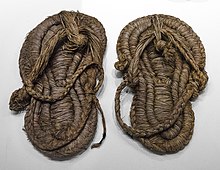

Ամենավաղ վկայությունները[խմբագրել | խմբագրել կոդը]
Հայտնի ամենավաղ կոշիկները որդանման կեղևի սանդալներն են, որոնք թվագրվում են Մ.թ.ա. մոտ 7000 կամ 8000 թվականներով, որոնք հայտնաբերվել են ԱՄՆ Օրեգոն նահանգի Ֆորտ Ռոք քարանձավում 1938 թվականին[5]: Աշխարհի ամենահին կաշվե կոշիկը, որը պատրաստված է կովի կաշվի մի կտորից, կաշվե լարով կապած է առջևի և հետևի կարերի վրա, հայտնաբերվել է Հայաստանի Արենի-1 քարանձավային համալիրում 2008 թվականին և ենթադրվում է, որ թվագրվում է Մ.թ.ա. 3500 թվականին[6][7]: Ötzi The Iceman կոշիկները, որոնք թվագրվում են Մ.թ.ա. 3300 թվականին, առանձնանում են շագանակագույն արջի մաշկի հիմքով, եղնիկի մաշկի կողային ներդիրներով և առափնյա պարանի ցանցով, որը ամուր փաթաթում էր ոտքը[6]: Հնէաբանները գնահատում են, որ այս կաշվե կոշիկը պատրաստվել է Մ.թ.ա. 1800-ից 1100 թվականներին ՝ այն դարձնելով Սկանդինավիայում հայտնաբերված ամենահին հագուստը: Կոշիկը հայտնաբերվել է 2006 թվականի օգոստոսին, երբ հնագետները կարծում են, որ այս կաշվե կոշիկը պատրաստվել է Մ.թ.ա. 1800-ից 1100 թվականներին[8][9], ինչը այն դարձնում է Սկանդինավիայում հայտնաբերված ամենահին հագուստը: Սանդալներ և բուսական մանրաթելերի վրա հիմնված այլ գործիքներ հայտնաբերվել են Կուևա դե լոս Մուրսիելագոսում, Ալբինյոլայում, Իսպանիայի հարավում, 2023 թվականին, որոնք թվագրվում են Մ.թ.ա. մոտ 7500-4200 թվականներին, ինչը նրանց դարձնում է Եվրոպայում հայտնաբերված ամենահին կոշիկը[10]:
Ենթադրվում է, որ կոշիկները գոյություն են ունեցել ավելի վաղ, բայց քանի որ օգտագործված նյութերը շատ շուտ փչացող են եղել, դժվար է գտնել ամենավաղ կոշիկների ապացույցները: այնուամենայնիվ, կան որոշ ապացույցներ, որոնք կարող են վկայել ամենաառաջին կոշիկների մասին[11]:
Կոշիկների կամ սանդալների մասին հուշում են ոտքերի հետքերը, քանի որ չեն հայտնաբերվել մատների հետքեր և երեք փոքր խորշեր, հետքերը հայտնաբերվել են Garden Route ազգային պարկում, Addo Elephant National Park-ում և Հարավային Աֆրիկայի Gucamma բնության արգելոցում[12]։ Դրանք թվագրվում են Մ.թ. ա. 73,000-ից 136,000 տարի ժամանակահատվածով: Նման կոշիկների գոյության հաստատումը այս ժամանակաշրջանին պատկանող ոսկրային կոճղերի գտածոն է, որից կարող էին պատրաստվել պարզ կոշիկներ[12]։
Ապացույցների մեկ այլ աղբյուր է մատների ոսկորների ուսումնասիրությունը, նկատվել է, որ դրանց հաստությունը նվազել է մոտ 40,000-ից 26,000 տարի առաջ: Սա հնէաբաններին հանգեցրել է այն եզրակացության, որ գոյություն է ունեցել կոշիկ սովորական, քանի որ դա հանգեցրել է ոսկորների ավելի քիչ աճի, ինչն էլ հանգեցրել էմատների կարճացման և նոսրացման[13]։ Ամենավաղ նմուշները շատ պարզ էին, Հաճախ դրանք պարզապես կաշվից պատրաստված "ոտնամաններ" էին ՝ ոտքերը քարերից, բեկորներից և ցրտից պաշտպանելու համար:
Հյուսիսային և Հարավային Ամերիկա[խմբագրել | խմբագրել կոդը]
Հյուսիսային Ամերիկայի շատ հին բնիկներ կրել են նմանատիպ տեսակի կոշիկներ, որոնք հայտնի են որպես մոկասիններ: Դրանք ամուր, փափուկ ներբաններով կոշիկներ են եղել, որոնք սովորաբար պատրաստվել են բիզոնի կամ այլ կենդանու: Շատ մոկասիններ զարդարված են եղել տարբեր ուլունքներով և զարդանախշերով[14]։ Մոկասինները նախատեսված չեն եղել անջրանցիկ լինելու համար, և խոնավ եղանակին և ամռան տաք ամիսներին բնիկ ամերիկացիների մեծ մասը ոտաբոբիկ է քայլել: Սիսալ բույսի տերևներն օգտագործվել են Հարավային Ամերիկայում թել պատրաստելուն՝ սանդալների, Մինչդեռ Մեքսիկայի բնիկները օգտագործել են Յուկա բույսը[15][16]։
Աֆրիկա և Մերձավոր Արևելք[խմբագրել | խմբագրել կոդը]
Երբ քաղաքակրթությունները սկսեցին զարգանալ, նրանք սկսեցին կրել ժապավենային սանդալներ, որոնք թվագրվում են Մ.թ. ա. 4000 թվականին": Թերևս "լավագույն" տերմինը օգտագործվել է Եգիպտոսի Թեբե քաղաքում՝ այս սանդալները նկարագրելու համար[17]։ Այս սանդալներից առաջինը հայտնաբերվել է միջին թագավորության դարաշրջանում, բայց հնարավոր է, որ դրանք հայտնվել են վաղ դինաստիկ շրջանում: Եվրոպայում հայտնաբերված մեկ զույգը պատրաստված է եղել պապիրուսի տերևներից և թվագրվել է մոտավորապես 1500 տարի[18]։ Դրանք կրել են նաև Երուսաղեմում քրիստոնեական դարաշրջանի առաջին դարում։ Շատ քաղաքակրթություններ հագնում էին ժապավենային սանդալներ որոնք նաև պատրաստում էին այլ նյութերից: Հին եգիպտական սանդալնել են պապիրուսից և արմավենու տերևներից։ Աֆրիկայի մասայները դրանք պատրաստել են հում կաշվից։ Հնդկաստանում դրանք պատրաստել են փայտից։
Չնայած ժապավենային սանդալները սովորաբար կրել են, հին ժամանակներում շատ ազգեր, ինչպիսիք են եգիպտացիները, հնդիկները և հույները, կոշիկի մեծ կարիք չեն տեսել ժամանակի մեծ մասը նախընտրել են ոտաբոբիկ քայլել[19]։ Եգիպտացիներն ու հնդիկները որոշ չափով օգտագործել են դեկորատիվ կոշիկներ, ինչպիսիք են առանց ներբանի սանդալները, որոնք հայտնի են որպես "Կլեոպատրա",որոնք ոչ մի պաշտպանություն չեն ապահովել ոտքերի համար:
Ասիա և Եվրոպա[խմբագրել | խմբագրել կոդը]
Հին հույները հիմնականում կոշիկները կրել են իրենց ցանկությամբ, համարելով ոչ էսթետիկ և ավելորդ: Կոշիկները հիմնականում կրել են թատրոնում ՝ որպես հասակն ավելացնելու միջոց, և շատերը նախընտրել են ոտաբոբիկ քայլել[19]։ Հին օլիմպիական խաղերին մարզիկները մասնակցել են ոտաբոբիկ և մերկ[20]: Նույնիսկ աստվածներին ու հերոսներին հիմնականում պատկերել են ոտաբոբիկ: Նրանք կռվել են ոտաբոբիկ, Ալեքսանդր Մակեդոնացին նվաճել է իր հսկայական կայսրությունը ոտաբոբիկ բանակներով[21]։
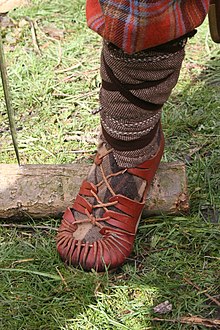
Հռոմեացիները, ովքեր նվաճել են հույներին և ընդունել են նրանց մշակույթի շատ ասպեկտներ, չեն ընդունել կոշիկի և հագուստի հունական ընկալումը: Հռոմեական հագուստը համարվել է ուժի նշան, իսկ կոշիկները ՝ քաղաքակիրթ աշխարհում ապրելու անհրաժեշտություն, թեև ստրուկներն ու մուրացկանները սովորաբար ոտաբոբիկ են քայլել[19]։ Հռոմեացի զինվորներին տրվել է քիրալ կոշիկներ (ձախ և աջ կոշիկները տարբերվում էին միմյանցից)[22]։ Soldierինվորական կոշիկներն ունեցել են գամված ներդիրներ ՝ կաշվի կյանքը երկարացնելու, հարմարավետությունը բարձրացնելու և ձգվածություն ապահովելու համար: Այս կոշիկների դիզայնը մատնանշել է սպաների կոչումը ։ Որքան ավելի բարդ են եղել նշանները, և որքան բարձր է եղել կոշիկը ոտքին, այնքան բարձր է եղել զինվորի կոչումը[23]: Աստվածաշնչում հիշատակություններ կան կոշիկ կրելու մասին ։ Չինաստանում և Ճապոնիայում օգտագործել են բրնձի Ծղոտներ։
Մոտավորապես մ.թ.ա. 4-ից հույները սկսել են կրել խորհրդանշական կոշիկներ։ Դրանք զարդարված են եղել՝ հստակ ցույց տալու համար սեփականատիրոջ կարգավիճակը։ Կուրտիզանուհիները կրել են կաշվե կոշիկներ՝ ներկված սպիտակ, կանաչ, կիտրոնի կամ դեղին գույներով, իսկ երիտասարդ կանայք ՝ նշանված կամ նոր ամուսնացած, կրել են լրիվ սպիտակ կոշիկներ: Ավելի բաց երանգի կոշիկները ավելի թանկ են եղել և հաանդիսացել են բարձր դասի, հարստության խորհրդանիսհ: Հաճախ ներբանների վրա հաղորդագրություն է փորագրվել, որպեսզի այն դրոշմվի գետնին: Այդ ժամանակ կոշկակարները դարձել են նշանավոր մասնագիտություն, իսկ հույն կոշկակարները հայտնի են դարձել Հռոմեական կայսրությունում[24]։
Միջին դարեր և վաղ նոր ժամանակներ[խմբագրել | խմբագրել կոդը]
Ասիա և Եվրոպա[խմբագրել | խմբագրել կոդը]
Միջնադարում Պիրենեյների սովորական ամենօրյա կոշիկները էսպադրիլներն են եղել։ Սրանք սանդալներ են եղել՝ հյուսված ջուտե ներբանով և գործվածքային վերևով, հաճախ գործվածքային ժանյակներով, որոնք կապվում են եղել կոճի շուրջը: Տերմինը ֆրանսերեն է և գալիս է էսպարտո խոտից։ Կոշիկը ծագել է Իսպանիայի Կատալոնիայի շրջանում դեռ 13-րդ դարում, և այն սովորաբար կրել են շրջանի ֆերմերային համայնքների գյուղացիները[16]:
Նոր ոճերը սկսել են զարգանալ Չինաստանի Սոնգ դինաստիայի օրոք, որոնցից մեկը ոտքերի ժապավենների դեբյուտն է եղել: Դրանք սկզբում օգտագործվում էին հանի ազնվական դասերի կողմից, բայց շուտով տարածվեցին ամբողջ հասարակության մեջ: Կանայք Այս կոշիկներն օգտագործել են իրենց "լոտոսի ոտքերը" զարգացնելու համար, ինչը գրավում էր տղամարդկանց: Ենթադրվում է, որ այս պրակտիկան սկիզբ է առել Շանգ դինաստիայի օրոք, բայց հայտնի է դարձել Մ.թ. մոտ 960 թվականին[25]:
Երբ մոնղոլները նվաճել են Չինաստանը, նրանք չեղարկել են պրակտիկան 1279 թվականին, իսկ մանչուները արգելել են ոտքերի վիրակապը 1644 թվականին ։ Հան ժողովուրդը, սակայն, շարունակել է օգտագործել այս ոճը ՝ առանց կառավարության մեծ միջամտության[25]:
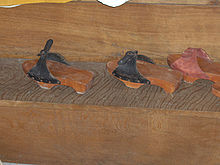
Միջնադարում կոշիկները կարող էին ունենալ մինչև երկու ոտնաչափ երկարություն, իսկ գուլպաները երբեմն լցված են մազերով, բուրդով, մամուռով կամ խոտով[26]: Միջնադարյան շատ կոշիկներ պատրաստված են եղել "շրջված ձիաձետի" մեթոդով, որի ժամանակ տերևը շրջել են աջ կողմը և դեպի դուրս, ձգել են ներբանի վրա և կարով միացրել եզրին[27]։ Այնուհետև կոշիկը շրջել են դեպի ներս, որպեսզի ներբանը դրսից լինի։ Կոշիկի որոշ տեսակներ նախագծել են ծալովի փեղկերով կամ կապերով, որպեսզի ավելի լավ տեղավորվի ոտքին[28]։ Մոտ 1500 թվականին turnshoe մեթոդը փոխարինվել է Rand-ի ճեղքված մեթոդով ( ըստ որի վերին մասը կարվել է շատ ավելի կոշտ ներբանի վրա, և կոշիկները չեն շրջվել ներսից[29]): Բայց Turnshoe մեթոդը օգտագործվել է որոշ պարային և հատուկ կոշիկներ պատրաստելու համար:
15-րդ դարում Եվրոպայում պատենները հայտնի են դարձել ինչպես տղամարդկանց, այնպես էլ կանանց շրջանում: Նրանք համարվել են ժամանակակից բարձրակրունկ կոշիկների նախորդներ, մինչդեռ Եվրոպայում աղքատներն ու ցածր խավերը, ինչպես նաև նոր աշխարհի ստրուկները ոտաբոբիկ են քայլել[30]: 15-րդ դարում Կրակովը նորաձև էր Եվրոպայում[19]։ Կոշիկի այս ոճն այդպես է կոչվել, քանի որ ենթադրվում է, որ այն ծագել է Լեհաստանի մայրաքաղաք Կրակովում: Այս ոճը բնութագրվել է կոշիկի գուլպանով, որը հայտնի է որպես "polaine", որը հաճախ աջակցվում էր ծնկին կապած կետի բեղերով, որպեսզի գուլպանը չխանգարի քայլելիս[31]: Այս կոշիկները հայտնի են դարձել Վենետիկում և ամբողջ Եվրոպայում ՝ որպես կարգավիճակի խորհրդանիշ, որը վկայել է հարստության և սոցիալական դիրքի մասին: 16-րդ դարում թագավորական ընտանիքի անդամները, ինչպիսիք են Եկատերինա Մեդիչին կամ անգլիացի Մարիա I-ը, սկսել են կրել բարձրակրունկ կոշիկներ ՝ ավելի բարձրահասակ կամ ավելի մեծ տեսք ունենալու համար, քան կյանքում: 1580 թվականին դրանք կրել են նույնիսկ տղամարդիկ, իսկ իշխանություն կամ հարստություն ունեցող մարդուն հաճախ անվանել են «բարձրակրունկ մարդ»[30]։ 17-րդ դարում Ֆրանսիայում կրունկները կրել են բացառապես արիստոկրատները։ Ֆրանսիայի թագավոր Լյուդովիկոս ՔՍԻՎ-ը արգելել է որևէ մեկին կրել կարմիր բարձրակրունկ կոշիկներ, բացառությամբ իր և իր թագավորական արքունիքի[32]:
Ի վերջո, հորինվել են ժամանակակից կոշիկներ ՝ կարված ներբաններով։ 17-րդ դարից սկսած ՝ կաշվե կոշիկների մեծ մասի համար օգտագործվել է կարված ներբան։ Սա 21-րդ դարում էլ մնում է ստանդարտ բարձրակարգ հագուստի կոշիկների համար: Մինչև մոտ 1800 թվականը Rand-ի ճեղքված կոշիկները սովորաբար պատրաստվել են առանց ձախ կամ աջ ոտքի տարբերակման: նման կոշիկները կոչվում են «ուղիղ»[33]:
Արդյունաբերական դարաշրջան[խմբագրել | խմբագրել կոդը]
Ասիա և եվրոպա[խմբագրել | խմբագրել կոդը]

Կոշիկի արտադրությունն ավելի առևտրայնացվել է 18-րդ դարի կեսերին, քանի որ այն ընդլայնվել է որպես արհեստագործական արդյունաբերություն: Տարածքի շատ փոքր արտադրողների կողմից պատրաստված կոշիկները սկսել են պահեստավորվել մեծ պահեստներում:
Մինչև 19-րդ դարը կոշիկի արտադրությունը Ավանդական արհեստ է եղել, բայց դարի վերջին գործընթացը գրեթե ամբողջությամբ մեքենայացված է եղել, և արտադրությունն իրականացվել է խոշոր գործարաններում: Չնայած զանգվածային արտադրության ակնհայտ տնտեսական օգուտներին, գործարանային համակարգը արտադրել է կոշիկներ ՝ առանց անհատական տարբերակման, որը կարողացել է ապահովել ավանդական կոշկագործը:
19-րդ դարում չինացի ֆեմինիստները կոչ են արել վերջ տալ ոտքերի ժապավենների օգտագործմանը, իսկ 1902 թվականին արգելել են։ Արգելքը հետո վերացվել է, մինչև 1911 թվականին այն կրկին արգելվել է նոր կառավարության կողմից: Այն արդյունավետ է եղել ափամերձ քաղաքներում, բայց գյուղական քաղաքները շարունակվել են գոյություն ունենալ առանց մեծ կարգավորման: Մաո Edզեդոնգը այս կանոնը գործի է դրել 1949 թվականին, և այն գործում է նաև 21-րդ դարում[25]:
Մեխանիզացման առաջին քայլերը ձեռնարկվել են Նապոլեոնյան պատերազմների ժամանակ ինժեներ Մարկ Բրյունելի կողմից ։ Նա բրիտանական բանակի զինվորների կոշիկների զանգվածային արտադրության համար սարքավորումներ է մշակել։ 1812 թվականին նա մշակել է մեխերով կոշիկ պատրաստելու մեքենա և սխեմա, որն ավտոմատ կերպով ամրացրել է ներբանները դեպի վեր ՝ օգտագործելով մետաղական քորոցներ կամ մեխեր: Յորքի դուքսի աջակցությամբ կոշիկները պատրաստվել են և, իրենց ամրության շնորհիվ օգտագործվել են բանակում[34]։ Նույն թվականին պտուտակների և փականների օգտագործումը արտոնագրվել է Ռիչարդ Վուդմանի կողմից: Բրունելի համակարգը նկարագրվել է սըր Ռիչարդ Ֆիլիպսի կողմից, ով այցելել է իր Բաթերսիի գործարան․

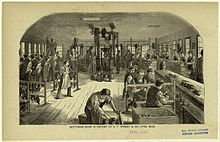
Արտադրության յուրաքանչյուր փուլում օգտագործվում են ամենաէլեգանտ և ճշգրիտ սարքավորումները, յուրաքանչյուր գործողություն կատարվում է մեկ ձեռքով, յուրաքանչյուր կոշիկ անցնում է քսանհինգ ձեռքի միջով, որոնք պատրաստված են կաշվից: Բոլոր մասերը պատրաստվում են մեխանիկական ունակությունների հնարամիտ կիրառմամբ և բոլոր մանրամասները տարբերվում կատարման ճշգրտությամբ: Քանի որ յուրաքանչյուր մարդ այս գործընթացում կատարում է միայն մեկ քայլ, ինչը ենթադրում է գիտելիքների պակաս այն մասին, թե ինչ են անում նրանք, ովքեր գնում են իրենից առաջ կամ հետևում են նրան, ուստի վարձու մարդիկ կոշկակարներ չեն, այլ վիրավոր զինվորներ, ովքեր ունակ են մի քանի ժամվա ընթացքում տիրապետել իրենց համապատասխան պարտականություններին: Պայմանագիրը, որով այս կոշիկները մատակարարվում են կառավարությանը, կազմում է 6 շիլլինգ 6 պենս մեկ զույգի համար, ինչը առնվազն 2 շիլլինգով պակաս է, քան նախկինում վճարվել էր անհավասար չափի և անհավասար մակերեսով ապրանքի համար[35]։
Այնուամենայնիվ, երբ պատերազմն ավարտվե էր 1815 թվականին, ձեռքի աշխատանքը շատ ավելի էր էժանացել, և ռազմական սարքավորումների պահանջարկը նվազել էր: Արդյունքում, Բրունելի համակարգը դադարել է շահույթ բերել, և շուտով այն դադարել է գործել[34]:
Հյուսիսային և Հարավային Ամերիկա[խմբագրել | խմբագրել կոդը]
Ղրիմի պատերազմի ժամանակ նմանատիպ պահանջները խթանել են մեխանիզացիայի և զանգվածային արտադրության մեթոդների նկատմամբ հետաքրքրության վերսկսումը, որոնք պարզվել է, որ ավելի դիմացկուն է[34]: Լեսթերից կոշկակար Թոմաս Քրիկը արտոնագրել է գամման մեքենայի դիզայնը 1853 թվականին: Նրա մեքենան օգտագործվել է որպես երկաթե ափսե ՝ երկաթե գամերը ներբանի մեջ սեղմելու համար։ Այս գործընթացը զգալիորեն մեծացրել է արտադրության արագությունն ու արդյունավետությունը: 1850 թվականների կեսերին նա նաև ներմուծել է գոլորշու շարժակազմերի օգտագործումը կաշվի կարծրացման և կտրող մեքենաների համար[36]:


Կարի մեքենան ներկայացվել է 1846 թվականին և ապահովել կոշիկի արտադրության մեքենայացման այլընտրանքային մեթոդ։ 1850 թվականների վերջին արդյունաբերությունը սկսել է վերակողմնորոշվել դեպի ժամանակակից գործարաններ, հիմնականում ԱՄՆ-ում և Անգլիայի որոշ տարածքներում: Կոշիկի կարի մեքենան հորինել է ամերիկացի Լայման Բլեյքը 1856 թվականին և կատարելագործել 1864 թվականին։ Համագործակցելով Մաքքեյի հետ ՝ Նրա սարքը հայտնի է դարձել որպես McKay կարի մեքենա և արագորեն ընդունվել արտադրողների կողմից Նոր Անգլիայում: Քանի որ այս նորարարությունների պատճառով արտադրական գծում խցանումներ են առաջացել, ավելի ու ավելի շատ արտադրական փուլեր, ինչպիսիք են գծանշումը և ավարտը, ավտոմատացվել են: 1890-ականներին մեքենայացման գործընթացը հիմնականում ավարտվել է[37]:
Գլոբալիզացիա[խմբագրել | խմբագրել կոդը]
Առանց կարերի, այսինքն ՝ սոսնձված կոշիկների պատրաստման գործընթացը՝ AGO-ն, մշակել է 1910 թվականին։ 20-րդ դարի կեսերից կաուչուկի, պլաստմասսայի, սինթետիկ գործվածքների և արդյունաբերական սոսինձների առաջընթացը արտադրողներին թույլ է տվել ստեղծել կոշիկներ, որոնք զգալիորեն տարբերվել են արտադրության ավանդական մեթոդներից: Կաշին, որն ավելի վաղ ոճերի հիմնական նյութն է եղել, մնացել է ստանդարտ թանկարժեք մոդելային կոշիկների մեջ, բայց սպորտային կոշիկները քիչ են պատրաստվում բնական կաշվից կամ ընդհանրապես չկան: Ներբանները, որոնք ժամանակին ձեռքով խնամքով կարվել են, այժմ ավելի հաճախ կարվում են մեքենայական կարով կամ պարզապես սոսնձվում են: Նոր նյութերից շատերը, ինչպիսիք են կաուչուկը և պլաստմասսաները, կոշիկները դարձրել են ավելի քիչ կենսաքայքայվող: Ենթադրվում է, որ զանգվածային արտադրության կոշիկների մեծ մասը 1000 տարի է պահանջում աղբանոցում քայքայվելու համար[38]: 2000 թվականների վերջին որոշ կոշկագործներ ուշադրություն սկսեցին դարձնել այս խնդրին և սկսեցին արտադրել կոշիկներ, որոնք ամբողջությամբ պատրաստված են քայքայվող նյութերից[39][40]։
2007 թվականին կոշիկի համաշխարհային արդյունաբերության ընդհանուր շուկան եկամուտների առումով կազմել է 107,4 միլիարդ դոլար։Չինաստանի Ժողովրդական Հանրապետությունում կոշիկ արտադրողներին բաժին է ընկնում արտադրության 63%-ը, համաշխարհային արտահանման 40,5%-ը և արդյունաբերության եկամուտների 55%-ը: Այնուամենայնիվ, Եվրոպայում շատ արտադրողներ գերակշռում են ավելի բարձր ավելացված արժեքով[41]:
Մշակույթ և Բանահյուսություն[խմբագրել | խմբագրել կոդը]
Որպես մարդկային մշակույթի և քաղաքակրթության անբաժանելի մաս՝ կոշիկներն իրենց արտացոլումն են գտել մեր մշակույթի, բանահյուսության և արվեստի մեջ:1948 թվականին Փենսիլվանիա նահանգի Հալամ քաղաքում կոշիկի վաճառող Մահլոն Հեյնսը որպես գովազդի ձև կառուցեց իսկական տուն ՝ աշխատանքային կոշիկի տեսքով։ Հեյնսի կոշիկի տունը վարձակալվել է նորապսակներին և տարեցներին մինչև նրա մահը ՝ 1962 թվականը: Այդ ժամանակից ի վեր այն ծառայել է որպես պաղպաղակի սրահ, մահճակալ և նախաճաշ և թանգարան: Այն դեռ կանգուն է և Հայտնի ճամփեզրի տեսարժան վայր է[42]։



Կոշիկները կարևոր դեր են խաղացել «Մոխրոտը» և «Կարմիր կոշիկները» մանկական գրքի էկրանավորման մեջ սյուժեում առանցքային դեր են խաղացել կարմիր ռուբինեային կոշիկները։ 1985 թվականի «Մարդը մեկ կարմիր կոշիկով» կատակերգությունում էքսցենտրիկ տղամարդը կրում է մեկ սովորական բիզնես կոշիկ և մեկ կարմիր կոշիկ, որը դառնում է սյուժեի կենտրոնական մասը ։
Աստվածաշնչի Հին Կտակարանում կոշիկներն օգտագործվել են անօգուտ կամ ցածրարժեք ինչ-որ բան նշելու համար: Նոր Կտակարանում կոշիկները հանելը խորհրդանշում է ստրկությունը: Հին սեմիտական ժողովուրդները կոշիկները հանելու գործողությունը դիտում էին որպես հարգանքի նշան, երբ մոտենում էին սուրբ մարդուն կամ վայրին[43]: Ելից գրքում Մովսես Մարգարեյին հանձնարարվել է հանել կոշիկները նախքան այրվող գմբեթին մոտենալը:
Կոշիկները հանելը խորհրդանշել է նաև օրինական իրավունքից հրաժարվելը։ Արաբական սովորույթի համաձայն ՝ կոշիկները հանելը նույնպես խորհրդանշում էր ամուսնության լուծարումը[43]։

Արաբական մշակույթում կոշիկի ներբանը ցույց տալը համարվում է վիրավորանք, իսկ կոշիկը նետելը և դրանով ինչ-որ մեկին հարվածելը համարվում է ավելի մեծ վիրավորանք: Կոշիկները համարվում են կեղտոտ, քանի որ դրանք հաճախ դիպչում են գետնին և կապված են մարմնի ստորին մասի ՝ ոտքերի հետ: Այսպիսով, մզկիթներում կոշիկներն արգելված են, և անքաղաքավարի է համարվում նաև զրույցի ընթացքում ոտքերը խաչելը և կոշիկի ներբանները ցուցադրելը[44]: Այս վիրավորանքը ցուցադրվեց Իրաքում, առաջին անգամ, երբ Սադամ Հուսեյնի արձանը տապալվեց 2003 թվականին, իրաքցիները հավաքվեցին դրա շուրջ և իրենց կոշիկներով հարվածեցին արձանին: 2008 թվականին Միացյալ Նահանգների նախագահ Ջորջ Վ. լրագրողը Բուշի վրա կոշիկ է նետել իրաքի պատերազմին դեմ արտահայտվելու համար[45]։ Ավելի ընդհանուր առմամբ, կոշիկ նետելը, ձեր կոշիկի ներբանը ցուցադրելը կամ վիրավորանքի համար կոշիկ օգտագործելը բողոքի ձևեր են աշխարհի շատ մասերում: Քաղաքական գործիչների վրա կոշիկ նետելու դեպքերը տեղի են ունեցել Ավստրալիայում, Հնդկաստանում, Իռլանդիայում, Թայվանում, Հոնկոնգում, Պակիստանում, Միացյալ Թագավորությունում, Միացյալ Նահանգներում և, առաջին հերթին, արաբական աշխարհում[46][47]:
Դատարկ կոշիկները կարող են նաև խորհրդանշել մահը: Հունական մշակույթում դատարկ կոշիկները համարժեք են ամերիկյան հուղարկավորության ծաղկեպսակին: Օրինակ ՝ հունական տնից դուրս դրված դատարկ կոշիկները շրջապատողներին կտեղեկացնեն, որ ընտանիքի որդին զոհվել է մարտում[48][49]։
Կառուցվածք[խմբագրել | խմբագրել կոդը]
Ցանկացած կոշիկ ունի ներբան, որը կոշիկի ստորին հատվածն է և շփվում է գետնի հետ։ Ներբանները կարող են պատրաստվել տարբեր նյութերից, չնայած ժամանակակից կոշիկների մեծ մասն ունի բնական կաուչուկից, պոլիուրեթանից կամ պոլիվինիլքլորիդից պատրաստված ներբաններ[50]: Ներբանները կարող են լինել պարզ՝ մեկ նյութից մինչև մեկ շերտ, կամ բարդ ՝ բազմաթիվ կառուցվածքներով կամ շերտերով և նյութերով: Տարբեր շերտեր օգտագործելիս ներբանները կարող են բաղկացած լինել ներդիրից, միջանկյալ ներբանից և պլանտարային ներբանից[51]:
Ներքնակը կոշիկի ներքին հատվածն է, որը գտնվում է անմիջապես ոտքի տակ ՝ ներքնակի տակ (հայտնի է նաև որպես գուլպաների երեսպատում): Ներդիրի նպատակն է կցվել վերևի ամուր եզրին, որը փաթաթվում է վերջինիս շուրջը, երբ կոշիկները փակվում են երկարատև շահագործման ընթացքում: Ներդիրները սովորաբար պատրաստվում են ցելյուլոզային ստվարաթղթից կամ սինթետիկ ոչ հյուսված ստվարաթղթից ՝ ներդիրների համար: Կոշիկի շատ տեսակներ ունեն շարժական և փոխարինելի ոտքերի ներդիրներ: Լրացուցիչ բարձիկավորումը հաճախ ավելացվում է հարմարավետության համար (կոշիկի ձևը, խոնավությունը կամ հոտը վերահսկելու համար) կամ առողջական նկատառումներից ելնելով (օգնելու հաղթահարել ոտքի բնական ձևի կամ ոտքի դիրքի տարբերությունները կանգնելիս կամ քայլելիս)[51]:
The insole is the interior bottom of a shoe, which sits directly beneath the foot under the footbed (also known as sock liner). The purpose of the insole is to attach to the lasting margin of the upper, which is wrapped around the last during the closing of the shoe during the lasting operation. Insoles are usually made of cellulosic paper board or synthetic non woven insole board. Many shoes have removable and replaceable footbeds. Extra cushioning is often added for comfort (to control the shape, moisture, or smell of the shoe) or health reasons (to help deal with differences in the natural shape of the foot or positioning of the foot during standing or walking).
Ներբանը շերտ է, որն անմիջականորեն շփվում է գետնի հետ ։ Հագուստի կոշիկները հաճախ ունեն կաշվից կամ պոլիմերային ռետինից պատրաստված ներբան; պատահական կոշիկները կամ աշխատանքային կոշիկները ունեն բնական ռետինե կամ սինթետիկ նյութից պատրաստված ներբան, ինչպիսին է պոլիուրեթանը: Ներբանը կարող է բաղկացած լինել մեկ կտորից կամ կարող է հավաքվել առանձին մասերից, հաճախ տարբեր նյութերից: Որոշ կոշիկների վրա ներբանի կրունկն ունի ռետինե ծածկույթ ՝ ամրության և ձգման համար, մինչդեռ առջևը կաշվից Է ՝ ոճ հաղորդելու համար: Մասնագիտացված կոշիկները հաճախ ունենում են այս դիզայնի փոփոխություններ.սպորտային կամ, այսպես կոչված, հասկերով կոշիկները, ինչպիսիք են ֆուտբոլի, ռեգբիի, բեյսբոլի և գոլֆի կոշիկները, ունեն հասկերներ, որոնք ներկառուցված են ներբանի մեջ ՝ ձգումը բարելավելու համար:
The outsole is the layer in direct contact with the ground. Dress shoes often have leather or resin rubber outsoles; casual or work-oriented shoes have outsoles made of natural rubber or a synthetic material like polyurethane. The outsole may comprise a single piece or may be an assembly of separate pieces, often of different materials. On some shoes, the heel of the sole has a rubber plate for durability and traction, while the front is leather for style. Specialized shoes will often have modifications on this design: athletic or so-called cleated shoes like soccer, rugby, baseball and golf shoes have spikes embedded in the outsole to improve traction.[51]
Միջանկյալ ներբանը ներբանի և ներբանի միջև եղած շերտն է, որը սովորաբար նախատեսված է բարձիկների կլանման համար: Կոշիկի որոշ տեսակներ, ինչպիսիք են վազող կոշիկները, ունեն լրացուցիչ նյութ ՝ բարձը կլանելու համար, սովորաբար կրունկի տակ, որտեղ մարդն առավելագույն ճնշում է գործադրում: Որոշ կոշիկներ կարող են ընդհանրապես չունենալ միջանկյալ ներբան:
The midsole is the layer in between the outsole and the insole, typically there for shock absorption. Some types of shoes, like running shoes, have additional material for shock absorption, usually beneath the heel of the foot, where one puts the most pressure down. Some shoes may not have a midsole at all.[51]
Կրունկը կոշիկի ստորին հետևի հատվածն է ։ Դրա գործառույթն է աջակցել ոտքի գարշապարը: Դրանք հաճախ պատրաստվում են նույն նյութից, ինչ կոշիկի ներբանը ։ Այս մասը կարող է բարձր լինել նորաձևության մեջ կամ մարդուն ավելի բարձր տեսք տալու համար, կամ հարթ ՝ ավելի գործնական և հարմարավետ օգտագործման համար: Որոշ կոշիկների վրա կրունկի ներքին առջևի հատվածը թեքված է, այս հատկությունը հայտնի է որպես "ջենթլմենի անկյուն": Դիզայնի այս տարրը նախատեսված է մեղմելու շալվարների ներքևի մասում ակնոցներ ներգրավելու խնդիրը և առաջին անգամ նկատվել է 1930-ականներին: Գարշապարը կոշիկի հետևի ելուստն է, որը գտնվում է գարշապարի ոսկորից ներքև: Կրունկը օգտագործվում է կոշիկի հավասարակշռությունը բարելավելու, Կրողի հասակը բարձրացնելու, կեցվածքը փոխելու կամ այլ դեկորատիվ նպատակներով: Բարձրակրունկը, երբեմն բարձրացված, բնորոշ է կոշիկներին, որոնք հաճախ կրում են կանայք, բայց երբեմն նաև տղամարդիկ: Տես նաեւ stiletto գարշապարը.
The heel is the bottom rear part of a shoe. Its function is to support the heel of the foot. They are often made of the same material as the sole of the shoe. This part can be high for fashion or to make the person look taller, or flat for more practical and comfortable use.[51] On some shoes the inner forward point of the heel is chiselled off, a feature known as a "gentleman's corner". This piece of design is intended to alleviate the problem of the points catching the bottom of trousers and was first observed in the 1930s.[52] A heel is the projection at the back of a shoe which rests below the heel bone. The shoe heel is used to improve the balance of the shoe, increase the height of the wearer, alter posture or other decorative purposes. Sometimes raised, the high heel is common to a form of shoe often worn by women, but sometimes by men too. See also stiletto heel.
Վերևը օգնում է կոշիկները պահել ոտքի վրա: Ամենապարզ դեպքերում, ինչպիսիք են սանդալները կամ մատնահետքերը, դրանք կարող են լինել ոչ ավելի, քան մի քանի ժապավեններ ՝ ներբանը տեղում պահելու համար: Փակ կոշիկները, ինչպիսիք են կոշիկները, սպորտային կոշիկները և տղամարդկանց կոշիկների մեծ մասը, կունենան ավելի բարդ գագաթ: Այս կտորը հաճախ զարդարված է կամ պատրաստված է որոշակի ոճով ՝ գրավիչ տեսք ունենալու համար: Վերևը ներբանին միացված է կաշվի, կաուչուկի կամ պլաստիկի շերտով, որը կարված է դրա և ներբանի միջև, որը հայտնի է որպես Ռանտ:
The upper helps hold the shoe onto the foot. In the simplest cases, such as sandals or flip-flops, this may be nothing more than a few straps for holding the sole in place. Closed footwear, such as boots, trainers and most men's shoes, will have a more complex upper. This part is often decorated or is made in a certain style to look attractive. The upper is connected to the sole by a strip of leather, rubber, or plastic that is stitched between it and the sole, known as a welt.[51]
Վերևի մոդելներից շատերն ունեն մեխանիզմ, ինչպիսիք են ժանյակները, ճարմանդային ժապավենները, կայծակաճարմանդները, առաձգական ժապավենները, Velcro-ն, կոճակները կամ սողնակները ' ոտքի գագաթը խստացնելու համար: Ժանյակներով վերևը սովորաբար ունի ներդիր, որն օգնում է փակել ժանյակային անցքը և պաշտպանել ոտքը ժանյակների քայքայումից: Ժանյակներով վերևը ունի նաև աչքեր կամ Կեռիկներ, որպեսզի ավելի հեշտ լինի ամրացնել և թուլացնել ժանյակները և կանխել ժանյակների պատռումը վերևի նյութի միջով: Ագլետը պաշտպանիչ փաթաթան է ժանյակի վերջում:
Most uppers have a mechanism, such as laces, straps with buckles, zippers, elastic, velcro straps, buttons, or snaps, for tightening the upper on the foot. Uppers with laces usually have a tongue that helps seal the laced opening and protect the foot from abrasion by the laces. Uppers with laces also have eyelets or hooks to make it easier to tighten and loosen the laces and to prevent the lace from tearing through the upper material. An aglet is the protective wrapping on the end of the lace.
Vamp-ը կոշիկի առջևի հատվածն է, որը սկսվում է մատի ետևում, անցնում է աչքերի և լեզվի շուրջը և ուղղված է դեպի կոշիկի հետևը:
The vamp is the front part of the shoe, starting behind the toe, extending around the eyelets and tongue and towards back part of the shoe.
Միջին մասը կոշիկի այն հատվածն է, որն ամենամոտ է մարդու համաչափության կենտրոնին, մինչդեռ կողային մասը գտնվում է հակառակ կողմում ՝ համաչափության կենտրոնից հեռու: Սա կարող է վերաբերել ինչպես ներբանին, այնպես էլ կարկատանը: Կոշիկի մեծ մասը վերին մասում ունի ժապավեններ, որոնք կապում են միջին և կողային մասերը այն բանից հետո, երբ մարդը կոշիկ է դնում և օգնում է կոշիկները պահել ոտքերի վրա: 1968 թ.-ին Puma SE-ն ներկայացրեց առաջին զույգ սպորտային կոշիկները ' ժապավենների փոխարեն Velcro ժապավեններով, և 1980-ականներին դրանք հայտնի դարձան հատկապես երեխաների և տարեցների շրջանում:
The medial is the part of the shoe closest to a person's center of symmetry, and the lateral is on the opposite side, away from their center of symmetry. This can be in reference to either the outsole or the vamp. Most shoes have shoelaces on the upper, connecting the medial and lateral parts after one puts their shoes on and aiding in keeping their shoes on their feet. In 1968, Puma SE introduced the first pair of sneakers with Velcro straps in lieu of shoelaces, and these became popular by the 1980s, especially among children and the elderly.[53][54]
Կոնդիլը այն հատվածն է, որը ծածկում և պաշտպանում է ձեր մատները: Ոտնաթաթի դեֆորմացիաներ ունեցող մարդիկ կամ մատների այտուցվածություն ունեցող մարդիկ (օրինակ ՝ միջքաղաքային վազորդները) սովորաբար պահանջում են ավելի մեծ կոնդիլ:
The toe box is the part that covers and protects the toes. People with toe deformities, or individuals who experience toe swelling (such as long-distance runners) usually require a larger toe box.[55]
-
Diagram of a typical dress shoe. The area labeled as the "Lace guard" is sometimes considered part of the quarter and sometimes part of the vamp.
-
A shoemaker making turnshoes at the Roscheider Hof Open Air Museum. English subtitles.
-
Cutaway view of a typical shoe.
Types[խմբագրել | խմբագրել կոդը]
Most types of shoes are designed for specific activities. For example, boots are typically designed for work or heavy outdoor use. Athletic shoes are designed for particular sports such as running, walking, or other sports. Some shoes are designed to be worn at more formal occasions, and others are designed for casual wear. There are also a vast variety of shoes designed for different types of dancing. Orthopedic shoes are special types of footwear designed for individuals with particular foot problems or special needs. Clinicians evaluate patient's footwear as a part of their clinical examination. However, it is often based on each individual's needs, with attention to the choice of footwear worn and if the shoe is adequate for the purpose of completing their activities of daily living.[56] Other animals, such as dogs and horses, may also wear special shoes to protect their feet as well.
Depending on the activity for which they are designed, some types of footwear may fit into multiple categories. For example, Cowboy boots are considered boots, but may also be worn in more formal occasions and used as dress shoes. Hiking boots incorporate many of the protective features of boots, but also provide the extra flexibility and comfort of many athletic shoes. Flip-flops are considered casual footwear, but have also been worn in formal occasions, such as visits to the White House.[57][58]
Athletic[խմբագրել | խմբագրել կոդը]
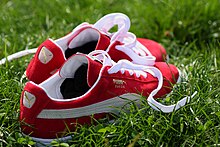
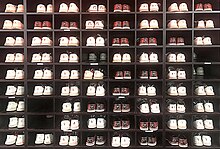
Athletic shoes are specifically designed to be worn for participating in various sports. Since friction between the foot and the ground is an important force in most sports, modern athletic shoes are designed to maximize this force, and materials, such as rubber, are used. Participants in sports in which sliding is desirable, such as dancing or bowling, wear shoes with lower coefficients of friction.[59] The earliest athletic shoes, dating to the mid-19th century, were track spikes—leather shoes with metal cleats on the soles to provide increased friction during running. They were developed by J.W. Foster & Sons, which later become known as Reebok. By the end of the 19th century, Spalding also manufactured these shoes as well. Adidas started selling shoes with track spikes in them for running and soccer in 1925. Spikes were eventually added to shoes for baseball and American football in the 20th century.[16] Golfers also use shoes with small metal spikes on their soles to prevent slipping during their swing.[60]
The earliest rubber-soled athletic shoes date back to 1876 in the United Kingdom, when the New Liverpool Rubber Company made plimsolls, or sandshoes, designed for the sport of croquet. Similar rubber-soled shoes were made in 1892 in the United States by Humphrey O'Sullivan, based on Charles Goodyear's technology. The United States Rubber Company was founded the same year and produced rubber-soled and heeled shoes under a variety of brand names, which were later consolidated in 1916 under the name, Keds. These shoes became known as, "sneakers", because the rubber sole allowed the wearer to sneak up on another person. In 1964, the founding of Nike by Phil Knight and Bill Bowerman of the University of Oregon introduced many new improvements common in modern running shoes, such as rubber waffle soles, breathable nylon uppers, and cushioning in the mid-sole and heel. During the 1970s, the expertise of podiatrists also became important in athletic shoe design, to implement new design features based on how feet reacted to specific actions, such as running, jumping, or side-to-side movement. Athletic shoes for women were also designed for their specific physiological differences.[16]
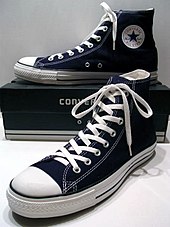
Shoes specific to the sport of basketball were developed by Chuck Taylor, and are popularly known as Chuck Taylor All-Stars. These shoes, first sold in 1917, are double-layer canvas shoes with rubber soles and toe caps, and a high heel (known as a "high top") for added support. In 1969, Taylor was inducted into the Naismith Memorial Basketball Hall of Fame in recognition of this development, and in the 1970s, other shoe manufacturers, such as Nike, Adidas, Reebok, and others began imitating this style of athletic shoe.[61] In April 1985, Nike introduced its own brand of basketball shoe which would become popular in its own right, the Air Jordan, named after the then-rookie Chicago Bulls basketball player, Michael Jordan. The Air Jordan line of shoes sold $100 million in their first year.[62]
As barefoot running became popular by the late 20th and early 21st century, many modern shoe manufacturers have recently designed footwear that mimic this experience, maintaining optimum flexibility and natural walking while also providing some degree of protection. Termed as Minimalist shoes, their purpose is to allow one's feet and legs to feel more subtly the impacts and forces involved in running, allowing finer adjustments in running style.[63] Some of these shoes include the Vibram FiveFingers,[64] Nike Free,[65] and Saucony's Kinvara and Hattori.[66][67] Mexican huaraches are also very simple running shoes, similar to the shoes worn by the Tarahumara people of northern Mexico, who are known for their distance running abilities.[68] Wrestling shoes are also very light and flexible shoes that are designed to mimic bare feet while providing additional traction and protection.
Many athletic shoes are designed with specific features for specific activities. One of these includes roller skates, which have metal or plastic wheels on the bottom specific for the sport of roller skating. Similarly, ice skates have a metal blade attached to the bottom for locomotion across ice. Skate shoes have also been designed to provide a comfortable, flexible and durable shoe for the sport of skateboarding.[69] Climbing shoes are rubber-soled, tight-fitting shoes designed to fit in the small cracks and crevices for rock climbing. Cycling shoes are similarly designed with rubber soles and a tight fit, but also are equipped with a metal or plastic cleat to interface with clipless pedals, as well as a stiff sole to maximize power transfer and support the foot.[70] Some shoes are made specifically to improve a person's ability to weight train.[71] Sneakers that are a mix between an activity-centered and a more standard design have also been produced: examples include roller shoes, which feature wheels that can be used to roll on hard ground, and Soap shoes, which feature a hard plastic sole that can be used for grinding.
Boot[խմբագրել | խմբագրել կոդը]
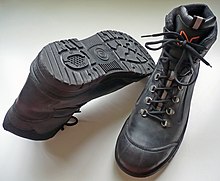
A boot is a special type of shoe which covers the foot and the ankle and extends up the leg, sometimes as far as the knee or even the hip. Most boots have a heel that is clearly distinguishable from the rest of the sole, even if the two are made of one piece. They are typically made of leather or rubber, although they may be made from a variety of different materials. Boots are worn both for their functionality—protecting the foot and leg from water, snow, mud or hazards or providing additional ankle support for strenuous activities—as well as for reasons of style and fashion.
Cowboy boots are a specific style of riding boots that combine function with fashion. They became popular among cowboys in the western United States during the 19th century. Traditional cowboy boots have a Cuban heel, rounded to pointed toe, high shaft, and, traditionally, no lacing.[72] They are normally made from cowhide leather but may be made from more exotic skins such as ostrich, anaconda, or elephant skins.[73]
Hiking boots are designed to provide extra ankle and arch support, as well as extra padding for comfort during hiking. They are constructed to provide comfort for miles of walking over rough terrains, and protect the hiker's feet against water, mud, rocks, and other wilderness obstacles. These boots support the ankle to avoid twisting but do not restrict the ankle's movement too much. They are fairly stiff to support the foot. A properly fitted boot and/or friction-reducing patches applied to troublesome areas ensures protection against blisters and other discomforts associated with long hikes on rugged terrain.[74]
During wet or snowy weather, snow boots are worn to keep the foot warm and dry. They are typically made of rubber or other water-resistant material, have multiple layers of insulation, and a high heel to keep snow out.[75] Boots may also be attached to snowshoes to increase the distribution of weight over a larger surface area for walking in snow. Ski boots are a specialized snow boot which are used in alpine or cross-country skiing and designed to provide a way to attach the skier to his/her skis using ski bindings. The ski/boot/binding combination is used to effectively transmit control inputs from the skier's legs to the snow. Ice skates are another specialized boot with a metal blade attached to the bottom which is used to propel the wearer across a sheet of ice.[76] Inline skates are similar to ice skates but with a set of three to four wheels in lieu of the blade, which are designed to mimic ice skating on solid surfaces such as wood or concrete.[77]
Boots are designed to withstand heavy wear to protect the wearer and provide good traction. They are generally made from sturdy leather uppers and non-leather outsoles. They may be used for uniforms of the police or military, as well as for protection in industrial settings such as mining and construction. Protective features may include steel-tipped toes and soles or ankle guards.[78]
Dress and casual[խմբագրել | խմբագրել կոդը]
Dress shoes are characterized by smooth and supple leather uppers, leather soles, and narrow sleek figure. Casual shoes are characterized by sturdy leather uppers, non-leather outsoles, and wide profile.
Some designs of dress shoes can be worn by either gender. The majority of dress shoes have an upper covering, commonly made of leather, enclosing most of the lower foot, but not covering the ankles. This upper part of the shoe is often made without apertures or openings, but may also be made with openings or even itself consist of a series of straps, e.g. an open toe featured in women's shoes. Shoes with uppers made high to cover the ankles are also available; a shoe with the upper rising above the ankle is usually considered a boot but certain styles may be referred to as high-topped shoes or high-tops. Usually, a high-topped shoe is secured by laces or zippers, although some styles have elastic inserts to ease slipping the shoe on.
Men's[խմբագրել | խմբագրել կոդը]

Men's shoes can be categorized by how they are closed:
- Oxfords (also referred as "Balmorals"): the vamp has a V-shaped slit to which the laces are attached; also known as "closed lacing". The word "Oxford" is sometimes used by American clothing companies to market shoes that are not Balmorals, such as bluchers.
- Derby shoe: the laces are tied to two pieces of leather independently attached to the vamp; also known as "open lacing" and is a step down in dressiness. If the laces are not independently attached to the vamp, the shoe is known as a blucher shoe. This name is, in American English, often used about derbys.
- Monk-straps: a buckle and strap instead of lacing
- Slip-ons: There are no lacings or fastenings. The popular loafers are part of this category, as well as less popular styles, such as elastic-sided shoes.
Men's shoes can also be decorated in various ways:
- Plain-toes: have a sleek appearance and no extra decorations on the vamp.
- Cap-toes: has an extra layer of leather that "caps" the toe.
- Brogues (American: wing-tips): The toe of the shoe is covered with a perforated panel, the wing-tip, which extends down either side of the shoe. Brogues can be found in both balmoral and blucher styles, but are considered slightly less formal.
Formal high-end men's shoes are manufactured by several companies around the world, amongst others in Great Britain, France, Hungary, Romania, Croatia, Italy, and to a lesser extent in the United States. Notable British brands include: Church's English Shoes (est. 1873), John Lobb Bootmaker (est. 1849), Edward Green Shoes (est. 1890), and Crockett & Jones (est. 1879). Both John Lobb and Edward Green offer bespoke products. In between the world wars, men's footwear received significant innovation and design, led by cobblers and cordwainers in London's West End.[79] A well-known French maker is J.M. Weston. Armani of Italy was a major influence on men's shoe design in the 1960s–1980s until they returned to the larger proportions of its forebears, the welt-constructed Anglo-American dress shoe originally created in Edwardian England. Another well-known Italian company is Salvatore Ferragamo Italia S.p.A. Higher end companies in the United States are Allen Edmonds and Alden Shoe Company. Alden, located in New England, specializes in genuine shell cordovan leather from the only remaining horse tannery in the US, in Chicago[80] and is completely manufactured domestically, whereas Allen Edmonds of Wisconsin is a larger company that outsources some of its production.[81]
Women's[խմբագրել | խմբագրել կոդը]

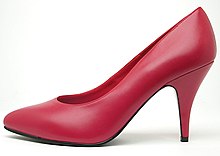
There is a large variety of shoes available for women, in addition to most of the men's styles being more accepted as unisex. Some broad categories are:
- High-heeled footwear is footwear that raises the heels, typically 2 inches (5 cm) or more above the toes, commonly worn by women for formal occasions or social outings. Variants include kitten heels (typically 1 1⁄2–2 inches high) and stiletto heels (with a very narrow heel post) and wedge heels (with a wedge-shaped sole rather than a heel post).
- Mules are shoes or slippers with no fitting around the heel (i.e. they are backless)
- Slingbacks are shoes which are secured by a strap behind the heel, rather than over the top of the foot.
- Ballet flats, known in the UK as ballerinas, ballet pumps or skimmers, are shoes with a very low heel and a relatively short vamp, exposing much of the instep. They are popular for warm-weather wear, and may be seen as more comfortable than shoes with a higher heel.
- Court shoes, known in the United States as pumps, are typically high-heeled, slip-on dress shoes.
Unisex[խմբագրել | խմբագրել կոդը]
- Clog
- Platform shoe: shoe with very thick soles and heels
- Sandals: open shoes consisting of a sole and various straps, leaving much of the foot exposed to air. They are thus popular for warm-weather wear, because they let the foot be cooler than a closed-toed shoe would.
- Saddle shoe: leather shoe with a contrasting saddle-shaped band over the instep, typically white uppers with black "saddle".
- Slip-on shoe: a dress or casual shoe without shoelaces or fasteners; often with tassels, buckles, or coin-holders (penny loafers).
- Boat shoes, also known as "deck shoes": similar to a loafer, but more casual. Laces are usually simple leather with no frills. Typically made of leather and featuring a soft white sole to avoid marring or scratching a boat deck. The first boat shoe was invented in 1935 by Paul A. Sperry.
- Slippers: For indoor use, commonly worn with pajamas.
Dance[խմբագրել | խմբագրել կոդը]
A vast variety of footwear is used by dancers. The choice of dance shoe type depends on the style of dance that is to be performed and, in many cases, the characteristics of the surface that will be danced on.
- Pointe shoes are designed for ballet dancing. These have a toe box that is stiffened with glue and a hardened sole so the dancer can stand on the tips of their toes. They are secured by elastic straps and ribbons that are tied to the dancer's ankles.
- Ballet shoes are soft, pliable shoes made of canvas or leather, with either continuous or two-part sole (also called split-sole), used for ballet dancing. The sole is typically made of leather, with thicker material under the ball and heel of the foot, and thinner and thus more flexible material under the arch so that the foot can be easily pointed. They are typically secured by elastics across the top of the foot.
- Ghillies are soft shoes that are used in Irish dance, Scottish country dance, and highland dance.
- Jazz shoes typically have a two-part rubberized sole (also called split-sole) to provide both flexibility and traction, and a short heel. They are secured to the foot by laces or elastic inserts.
- Tango and Flamenco shoes are used for tango or flamenco dancing.
- Ballroom shoes fall into two categories: Ballroom and Latin American. Both are characterised by suede soles. Men's ballroom shoes are typically lace-ups with one-inch heels and patent leather uppers. Ladies' ballroom shoes are typically court shoes with two-inch heels, made of fabric that can be colored to match the dancer's dress. In contrast to the low Ballroom heel, which evenly distributes weight across the foot, Latin American shoes have higher heels designed to shift weight onto the toes. Latin shoes are also more flexible than ballroom shoes. Men's Latin shoes typically have 1.5- to 2-inch high, shaped heels, while Ladies' Latin shoes have 2.5-inch to 3-inch heels. Ladies shoes are typically open-toed and strapped.
- Dance sneakers are lightweight sneakers with reinforced rubber toes that allows dancers to briefly stand on their toes. These are known by various trademarked names, such as dansneakers.
- Foot thongs are slip-on, partial foot covers that cover the ball of the dancer's foot so as to reduce friction while executing turns, thus making it easier to perform turns and also protecting the foot from skin abrasions. From a distance, flesh colored foot thongs give a dancer the appearance of having bare feet. They are known by various names depending on the manufacturer, including dance paws, foot undies, and foot paws.
- Tap shoes have metal plates mounted to the bottoms of the toe and heel. The metal plates, which are known as taps, make a loud sound when struck against a hard performance surface. Tap shoes, which are used in tap dancing, may be made from any style of shoe to which taps can be attached.
- Character shoes are leather shoes with one- to three-inch heels, usually with one or more straps across the instep to secure it to the foot. They may be soft-soled (suede) or hard-soled. They may be converted to tap shoes by attaching taps.
- Kierpce are traditional dance shoes in German, Polish, Slovakian, Lithuanian, Latvian and maybe other cultures. They are lightweight, do not have a sole, and are made with leather. Traditionally white wool socks are worn alongside kierpces.
-
Jazz shoes. This style is frequently worn by acro dancers
-
A foot thong, viewed from the bottom
-
Ladies' ballroom shoes
-
Men's ballroom shoes
-
Children's shoe from the early 80s.
Orthopedic[խմբագրել | խմբագրել կոդը]

Orthopedic shoes are specially-designed footwear to relieve discomfort associated with many foot and ankle disorders, such as blisters, bunions, calluses and corns, hammer toes, plantar fasciitis, or heel spurs. Certain types of therapeutic footwear are prescribed for children[82][83] with mobility issues.[84] They may also be worn by individuals with diabetes or people with unequal leg length. These shoes typically have a low heel, tend to be wide with a particularly wide toe box, and have a firm heel to provide extra support. Some may also have a removable insole, or orthotic, to provide extra arch support.[16]
Measures and sizes[խմբագրել | խմբագրել կոդը]
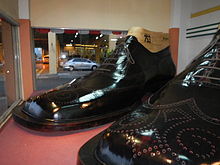
The measure of a foot for a shoe is from the heel to the longest toe. Shoe size is an alphanumerical indication of the fitting size of a shoe for a person. Often it just consists of a number indicating the length because many shoemakers only provide a standard width for economic reasons. Globally, several different shoe-size systems are used, differing in their units of measurement and in the position of sizes 0 and 1. Only a few systems also take the width of the feet into account. Some regions use different shoe-size systems for different types of shoes (e.g., men's, women's, children's, sport, or safety shoes).
Units for shoe sizes vary vastly around the world. European sizes are measured in Paris Points, each measuring two-thirds of a centimeter. The UK and American units result in whole-number sizes spaced at one barleycorn (1⁄3 inch), with UK adult sizes starting at size 1 = 8 2⁄3 in (22.0 cm). In the US, this is size 2. Men's and women's shoe sizes often have different scales.[փա՞ստ] Shoe size is often measured using a Brannock Device, which can determine both the width and length size values of the foot.[85] A metric standard for shoe sizing, the Mondopoint system, was introduced in the 1970s by International Standard ISO 2816:1973 "Fundamental characteristics of a system of shoe sizing to be known as Mondopoint" and ISO 3355:1975 "Shoe sizes – System of length grading (for use in the Mondopoint system)".[86] the current version of the standard is ISO 9407:2019, "Shoe sizes—Mondopoint system of sizing and marking".[87] The Mondopoint system includes measurements of both length and width of the foot.
Accessories[խմբագրել | խմբագրել կոդը]
Crampons are spiked attachments designed for navigating icy terrain, providing traction for activities like ice climbing. Foam taps are used to adjust the fit of shoes, particularly useful when a shoe feels loose. Heel grips help prevent shoes from slipping at the heel, offering added security in fit. Ice cleats offer traction on slippery surfaces, such as ice or snow, enhancing stability. Overshoes or galoshes provide a protective layer over shoes, shielding them from rain and snow. Shoe bags are used to store and protect shoes when not in use. Shoe brushes and polishing cloths are tools for maintaining the appearance of shoes. Shoe inserts or insoles offer additional comfort and support, catering to different foot needs. Shoe polish is applied to shoes to improve their appearance and provide protection. Shoe stretchers are used to adjust the size or shape of shoes for improved fit. Shoe trees help maintain the shape of shoes when they are not being worn. Shoehorns assist in putting on shoes, especially those with a snug fit. Shoelaces are used to secure shoes in place. Snowshoes are footwear attachments that increase the surface area of the shoe for better traction in snowy conditions.
Removal of shoes[խմբագրել | խմբագրել կոդը]
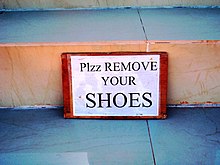
In many places in the world, shoes are removed when moving from exteriors to interiors, particularly in homes and religious buildings. In many Asian countries, outdoor shoes are exchanged for indoor shoes or slippers. Some fitness centres require that shoes be exchanged for indoor shoes to prevent dirt and grime from being transferred to the equipment.[փա՞ստ]
References[խմբագրել | խմբագրել կոդը]
- ↑ 1,0 1,1 1,2 Hoskins, Tansy E. (2020-03-21). «'Some soles last 1,000 years in landfill': the truth about the sneaker mountain». The Guardian (անգլերեն). Վերցված է 2021-02-19-ին.
- ↑ «The Scottish Ten». The Engine Shed. Centre for Digital Documentation and Visualisation LLP. Վերցված է 14 October 2017-ին.
- ↑ «Lady's Shoe, Bar Hill». 2015-09-25. Վերցված է 24 May 2018-ին.
- ↑ «Child's Shoe, Bar Hill». 2015-09-22. Վերցված է 24 May 2018-ին.
- ↑ Connolly, Tom. «The World's Oldest Shoes». University of Oregon. Արխիվացված օրիգինալից July 22, 2012-ին. Վերցված է July 22, 2012-ին.
- ↑ 6,0 6,1 Ravilious, Kate (June 9, 2010). «World's Oldest Leather Shoe Found—Stunningly Preserved». National Geographic. Արխիվացված է օրիգինալից July 24, 2012-ին. Վերցված է July 22, 2012-ին.
- ↑ Petraglia, Michael D.; Pinhasi R; Gasparian B; Areshian G; Zardaryan D; Smith A; և այլք: (2010). Petraglia, Michael D. (ed.). «First Direct Evidence of Chalcolithic Footwear from the Near Eastern Highlands». PLOS ONE. 5 (6): e10984. Bibcode:2010PLoSO...510984P. doi:10.1371/journal.pone.0010984. PMC 2882957. PMID 20543959. Reported in (among others) Belluck, Pam (9 June 2010). «This Shoe Had Prada Beat by 5,500 Years». The New York Times. Արխիվացված օրիգինալից 11 June 2010-ին. Վերցված է 11 June 2010-ին.
- ↑ Nesje, Atle; Pilø, Lars Holger; Finstad, Espen; Solli, Brit; Wangen, Vivian; Ødegård, Rune Strand; Isaksen, Ketil; Støren, Eivind N.; Bakke, Dag Inge; Andreassen, Liss M (2011). «The climatic significance of artefacts related to prehistoric reindeer hunting exposed at melting ice patches in southern Norway». The Holocene. 22 (4): 485–496. doi:10.1177/0959683611425552. ISSN 0959-6836. S2CID 129845949.
- ↑ "Old Shoe- Even Older". The Norway Post, 2 May 2007. Արխիվացված 8 Մարտ 2016 Wayback Machine
- ↑ Francisco Martínez-Sevilla; և այլք: (27 Sep 2023). «The earliest basketry in southern Europe: Hunter-gatherer and farmer plant-based technology in Cueva de los Murciélagos (Albuñol)». ScienceAdvances. 9 (39): eadi3055. Bibcode:2023SciA....9I3055M. doi:10.1126/sciadv.adi3055. PMC 10530072. PMID 37756397.
- ↑ Johnson, Olivia (August 24, 2005). «Bones Reveal First Shoe-Wearers». BBC News. Արխիվացված օրիգինալից June 3, 2012-ին. Վերցված է July 23, 2012-ին.
- ↑ 12,0 12,1 Helm, Charles W.; Lockley, Martin G.; Cawthra, Hayley C.; De Vynck, Jan C.; Dixon, Mark G.; Rust, Renée; Stear, Willo; Van Tonder, Monique; Zipfel, Bernhard (2023). «Possible shod-hominin tracks on South Africa's Cape coast». Ichnos: 1–19. doi:10.1080/10420940.2023.2249585. ISSN 1042-0940. S2CID 261313433.
- ↑ Trinkaus, E.; Shang, H. (July 2008). «Anatomical Evidence for the Antiquity of Human Footwear: Tianyuan and Sunghir». Journal of Archaeological Science. 35 (7): 1928–1933. Bibcode:2008JArSc..35.1928T. doi:10.1016/j.jas.2007.12.002.
- ↑ Laubin, Reginald; Laubin, Gladys; Vestal, Stanley (1977). The Indian Tipi: Its History, Construction, and Use. Norman, Oklahoma: University of Oklahoma Press. ISBN 978-0-8061-2236-6. Արխիվացված օրիգինալից 2018-04-27-ին.
- ↑ Kippen, Cameron (1999). The History of Footwear. Perth, Australia: Department of Podiatry, Curtin University of Technology.
- ↑ 16,0 16,1 16,2 16,3 16,4 DeMello, Margo (2009). Feet and Footwear: A Cultural Encyclopedia. Santa Barbara, California: ABC-CLIO, LLC. էջեր 20–24, 90, 108, 130–131, 226–230. ISBN 978-0-313-35714-5.
- ↑ «Egypt: The Birthplace of Flip Flops? – The Sheridan Libraries & University Museums Blog» (ամերիկյան անգլերեն). 21 July 2017. Վերցված է 2022-05-20-ին.
- ↑ Kendzior, Russell J. (2010). Falls Aren't Funny: America's Multi-Billion-Dollar Slip-and-Fall Crisis. Lanham, Maryland: www.govtinstpress.com/ Government Institutes. էջ 117. ISBN 978-0-86587-016-1. Արխիվացված օրիգինալից 2017-03-19-ին.
- ↑ 19,0 19,1 19,2 19,3 Frazine, Richard Keith (1993). The Barefoot Hiker. Ten Speed Press. էջ 98. ISBN 978-0-89815-525-9.
- ↑ «Unearthing the First Olympics». NPR. July 19, 2004. Արխիվացված է օրիգինալից July 28, 2010-ին. Վերցված է July 1, 2010-ին.
- ↑ Krentz, Peter (2010). The Battle of Marathon. New Haven and London: Yale University Press. էջեր 112–113. ISBN 978-0-300-12085-1. Արխիվացված օրիգինալից 2018-04-27-ին.
- ↑ 'Greece and Rome at War' by Peter Connolly
- ↑ Swann, June (2001). History of Footwear in Norway, Sweden and Finland: Prehistory to 1950. Kungl. Vitterhets, historie och antikvitets akademien. ISBN 9789174023237.
- ↑ Ledger, Florence (1985). Put Your Foot Down: A Treatise on the History of Shoes. C. Venton. ISBN 9780854751112.
- ↑ 25,0 25,1 25,2 «The History of Foot Binding in China». ThoughtCo (անգլերեն). Վերցված է 2022-05-17-ին.
- ↑ Ruth Hibbard (9 Jul 2015). «Getting To The Point Of Medieval Shoes». Victoria & Albert Museum. Վերցված է 4 Oct 2021-ին.
- ↑ «Making Basic Viking-Age Men's Clothing». www.vikingsof.me. Վերցված է 2020-11-07-ին.
- ↑ 'Shoes and Pattens: Finds from Medieval Excavations in London' (Medieval Finds from Excavations in London) by Francis Grew & Margrethe de Neergaard
- ↑ Blair, John (1991). English Medieval Industries: Craftsmen, Techniques, Products. London: Continuum International Publishing Group. էջ 309. ISBN 978-0-907628-87-3. Արխիվացված օրիգինալից 2016-04-25-ին.
- ↑ 30,0 30,1 «Dangerous Elegance: A History of High-Heeled Shoes». Random History. Արխիվացված է օրիգինալից July 28, 2010-ին. Վերցված է July 1, 2010-ին.
- ↑ The Encyclopaedia of the Renaissance. Market House Books. 1988. ISBN 978-0-7134-5967-8.
- ↑ Riello, Giorgio; McNeil, Peter (March 2007). «Footprints from History». History Today. 57 (3).
- ↑ Yue, Charlotte (1997). Shoes: Their History in Words and Pictures. New York City: Houghton Mifflin Company. էջեր 46. ISBN 978-0-395-72667-9. «straights+shoes.»
- ↑ 34,0 34,1 34,2 «History of Shoemaking in Britain—Napoleonic Wars and the Industrial Revolution». Արխիվացված օրիգինալից 2014-02-02-ին.
- ↑ Richard Phillips, Morning's Walk from London to Kew, 1817.
- ↑ R. A. McKinley (1958). «FOOTWEAR MANUFACTURE». British History Online. Արխիվացված օրիգինալից 2014-02-03-ին.
- ↑ O'Sullivan, Gary B (2007). The Oak and Serpent. Lulu. էջ 300. ISBN 978-0615155579. Վերցված է 2019-01-24-ին.
- ↑ Clark, Brian (October 24, 2009). «Biodegradable... Shoes??». The Daily Green. Արխիվացված է օրիգինալից September 20, 2012-ին. Վերցված է July 23, 2012-ին.
- ↑ «What is Nike Considered?». Nike, Inc. Վերցված է July 23, 2012-ին.
- ↑ «Ground-breaking Technology Brings World's First Biodegradable Midsole to Runners». CSR Press Release. November 15, 2007. Արխիվացված օրիգինալից July 28, 2012-ին. Վերցված է July 23, 2012-ին.
- ↑ «Global Footwear Manufacturing Industry Market Research Report». PRWeb. June 7, 2012. Արխիվացված օրիգինալից March 13, 2013-ին. Վերցված է July 24, 2012-ին.
- ↑ Lake, Matt; Moran, Mark; Sceurman, Mark (2005). Weird Pennsylvania: Your Travel Guide to Pennsylvania's Local Legends and Best Kept Secrets. New York City: Sterling Publishing Co. էջ 131. ISBN 978-1-4027-3279-9. Արխիվացված օրիգինալից 2016-03-06-ին.
- ↑ 43,0 43,1 Farbridge, Maurice H. (2003). Studies in Biblical & Semitic Symbolism 1923. Kessinger Publishing. ISBN 978-0-7661-3856-8. Արխիվացված օրիգինալից 2016-12-22-ին., pages=273–274
- ↑ Gammell, Caroline (December 15, 2008). «Arab Culture: The Insult of the Shoe». The Daily Telegraph. Արխիվացված օրիգինալից July 25, 2012-ին. Վերցված է July 24, 2012-ին.
- ↑ Asser, Martin (December 15, 2008). «Bush Shoe-ing Worst Arab Insult». BBC News. Արխիվացված օրիգինալից October 16, 2012-ին. Վերցված է July 24, 2012-ին.
- ↑ Arab culture: the insult of the shoe Արխիվացված 2018-03-12 Wayback Machine, The Telegraph, 15 December 2008.
- ↑ Bush shoe-ing worst Arab insult Արխիվացված 2012-05-30 Wayback Machine, BBC, 16 December 2008.
- ↑ Reeve, Andru J. (2004). Turn Me On, Dead Man: The Beatles and the "Paul Is Dead" Hoax. Bloomington, Indiana: AuthorHouse. էջ 79. ISBN 978-1-4184-8294-7. Արխիվացված օրիգինալից 2016-04-27-ին.
- ↑ Cohen, Sam (September 11, 2011). «Empty Shoes an Emotional Reminder of Those Who Died on 9/11». Fox 40. Վերցված է July 23, 2012-ին.(չաշխատող հղում)
- ↑ Karak, Niranjan (2009). Fundamentals Of Polymers: Raw Materials To Finish Products. New Delhi: PHI Learning Private Limited. էջեր 263–264. ISBN 978-81-203-3877-7. Արխիվացված օրիգինալից 2016-05-13-ին.
- ↑ 51,0 51,1 51,2 51,3 51,4 51,5 Vonhof, John (2011). Fixing Your Feet: Prevention and Treatments for Athletes. Birmingham, Alabama: Wilderness Press. էջեր 58–59. ISBN 978-0-89997-638-9. Արխիվացված օրիգինալից 2016-05-06-ին.
- ↑ Oliver Sweeney Ltd. «Home Page—Oliver Sweeney». oliversweeney.com. Արխիվացված է օրիգինալից 2014-10-04-ին.
- ↑ Suddath, Claire (June 15, 2010). «A Brief History of: Velcro». Time. Արխիվացված է օրիգինալից September 13, 2012-ին. Վերցված է July 30, 2012-ին.
- ↑ Frank, Robert H. (2007). The Economic Naturalist: In Search of Explanations for Everyday Enigmas. New York City: Basic Books. էջեր 174. ISBN 978-0-465-00217-7. «velcro laces.»
- ↑ Edelstein, Joan E.; Bruckner, Jan (2002). Orthotics: A Comprehensive Clinical Approach. SLACK Incorporated. էջեր 21. ISBN 978-1-55642-416-8.
- ↑ Ellis, Stephen; Branthwaite, Helen; Chockalingam, Nachiappan (December 2022). «Evaluation and optimisation of a footwear assessment tool for use within a clinical environment». Journal of Foot and Ankle Research. 15 (1): 12. doi:10.1186/s13047-022-00519-6. PMC 8829975. PMID 35144665.
- ↑ Ward, Julie (September 13, 2005). «Next big step in team spirit: Flip-flops». USA Today. Արխիվացված օրիգինալից August 9, 2011-ին. Վերցված է July 19, 2012-ին.
- ↑ Lister, Richard (February 19, 2010). «Flip-flop Diplomacy With the Dalai Lama». BBC News. Արխիվացված օրիգինալից October 16, 2012-ին. Վերցված է July 19, 2012-ին.
- ↑ McGinnis, Peter M. (2005). Biomechanics of Sport and Exercise (Second ed.). Champaign, Illinois: www.humankinetics.com. էջ 26. ISBN 978-0-7360-5101-9. Արխիվացված օրիգինալից 2016-04-29-ին.
- ↑ Farrally, Martin R.; Cochran, Alastair J. (1999). Science and Golf III: Proceedings of the 1998 World Scientific Congress of Golf. Champaign, Illinois: www.humankinetics.com. էջեր 568–569. ISBN 978-0-7360-0020-8. Արխիվացված օրիգինալից 2016-05-18-ին.
- ↑ Peterson, Hal (2007). Chucks!: The Phenomenon of Converse Chuck Taylor All Stars. New York City: Skyhorse Publishing. ISBN 978-1-60239-079-9. Արխիվացված օրիգինալից 2016-05-11-ին.
- ↑ Papson, Stephen; Goldman, Robert (1998). Nike Culture: The Sign of the Swoosh. London: SAGE Publications. էջ 47. ISBN 978-0-7619-6148-2. Արխիվացված օրիգինալից 2016-05-17-ին.
- ↑ Winters, Dan (November 2010). «Is Less More?». Runner's World. Արխիվացված է օրիգինալից July 28, 2012-ին. Վերցված է July 23, 2012-ին.
- ↑ «Vibram FiveFingers Named A "Best Invention of 2007" by Time Magazine». trailspace.com. 12 November 2007. Արխիվացված օրիգինալից 13 May 2010-ին. Վերցված է June 26, 2010-ին.
- ↑ Cortese, Amy (August 29, 2009). «Wiggling Their Toes at the Shoe Giants». The New York Times. Արխիվացված օրիգինալից April 4, 2011-ին. Վերցված է July 1, 2010-ին.
- ↑ «Saucony Progrid Kinvara Running Shoe Review: Runner's World». Runner's World. February 15, 2008. Արխիվացված է օրիգինալից September 11, 2011-ին. Վերցված է September 3, 2011-ին.
- ↑ Jhung, Lisa (May 2011). «Saucony Minimalism». Runner's World. Արխիվացված է օրիգինալից 2011-05-06-ին. Վերցված է August 17, 2011-ին.
- ↑ McDougall, Christopher (2011). Born to Run: A Hidden Tribe, Superathletes, and the Greatest Race the World Has Never Seen. New York City: Vintage Books. էջեր 168, 172. ISBN 978-0-307-27918-7. «born to run.»
- ↑ Welinder, Per; Whitley, Peter (2012). Mastering Skateboarding. Champaign, Illinois: Human Kinetics. էջ 8. ISBN 978-0-7360-9599-0. Արխիվացված օրիգինալից 2016-06-24-ին.
- ↑ International Police Mountain Bike Association (2008). The Complete Guide to Public Safety Cycling. Sudbury, Massachusetts: Jones & Bartlett Publishers. էջ 45. ISBN 978-0-7637-4433-5. Արխիվացված օրիգինալից 2016-05-19-ին.
- ↑ Radding, Ben (November 15, 2018). «The Best Weightlifting Shoes, According to Trainers». Yahoo Life.
- ↑ DeWeese, G. Daniel (June 29, 2010). «The Functional Side of Cowboy Boots». True West Magazine. Արխիվացված է օրիգինալից October 16, 2012-ին. Վերցված է August 10, 2012-ին.
- ↑ Chand, Elise Gaston (2009). A Parent's Guide to Riding Lessons: Everything You Need to Know to Survive and Thrive With a Horse-Loving Kid. North Adams, Massachusetts: Storey Publishing. էջ 91. ISBN 978-1-60342-447-9. Արխիվացված օրիգինալից 2016-05-10-ին.
- ↑ Howe, Steve (March 2002). «Boots». Backpacker. Արխիվացված օրիգինալից March 18, 2013-ին. Վերցված է August 10, 2012-ին.
- ↑ Stimpert, Desiree. «What Makes a Boot a Snow Boot». Արխիվացված օրիգինալից July 23, 2012-ին. Վերցված է August 10, 2012-ին.
{{cite news}}: Check|url=value (օգնություն) - ↑ Bellis, Mary. «History of Ice Skates». [[]]. Արխիվացված է օրիգինալից December 5, 2012-ին. Վերցված է August 10, 2012-ին.
{{cite news}}: Check|url=value (օգնություն) - ↑ Olsen, Scott & Brennan. «Inline-Skates». lemelson.mit.edu. Արխիվացված օրիգինալից May 2, 2006-ին. Վերցված է August 10, 2012-ին.
- ↑ Somaiya, A.; James, E.; Wieffering, N. (2008). Construction Materials. Forest Drive, Pinelands, Cape Town: Pearson Education South Africa. էջ 36. ISBN 978-1-77025-156-4. Արխիվացված օրիգինալից 2016-05-08-ին.
- ↑ Flusser, Alan. "Dressing the Man" Harper Collins, 2002, pg 189.
- ↑ Wong, Wailin (December 26, 2014). «Chicago's last tannery». Chicago Tribune. Արխիվացված է օրիգինալից October 24, 2020-ին.
- ↑ «Ask Andy About Clothes». Արխիվացված է օրիգինալից 2010-12-12-ին.
- ↑ Hill, Matthew; Healy, Aoife; Chockalingam, Nachiappan (December 2019). «Key concepts in children's footwear research: a scoping review focusing on therapeutic footwear». Journal of Foot and Ankle Research. 12 (1): 25. doi:10.1186/s13047-019-0336-z. PMC 6487054. PMID 31061678.
- ↑ Hill, Matthew; Healy, Aoife; Chockalingam, Nachiappan (December 2020). «Effectiveness of therapeutic footwear for children: A systematic review». Journal of Foot and Ankle Research. 13 (1): 23. doi:10.1186/s13047-020-00390-3. PMC 7222438. PMID 32404124.
- ↑ Hill, Matthew; Healy, Aoife; Chockalingam, Nachiappan (August 2021). «Defining and grouping children's therapeutic footwear and criteria for their prescription: an international expert Delphi consensus study». BMJ Open. 11 (8): e051381. doi:10.1136/bmjopen-2021-051381. ISSN 2044-6055. PMC 8354267. PMID 34373314.
- ↑ US patent 1725334, "Foot-measuring instrument", published 1929-08-20
- ↑ R. Boughey. Size Labelling of Footwear. Journal of Consumer Studies & Home Economics. Volume 1, Issue 2. June 1977. DOI:10.1111/j.1470-6431.1977.tb00197.x
- ↑ International Standard ISO 9407:2019, Shoe sizes—Mondopoint system of sizing and marking
Bibliography[խմբագրել | խմբագրել կոդը]
- Bergstein, Rachelle (2012). Women from the Ankle Down: The Story of Shoes and How They Define Us (Hardback). New York: Harper Collins. էջեր 284 pages. ISBN 978-0-06-196961-4.
- Doe, Tamasin (1998), Patrick Cox: Wit, Irony, and Footwear, 0-8230-1148-8.
- Pattison, Angela, A Century of Shoes: Icons of Style in the 20th Century, 0-7858-0835-3.
- Swann, June. History of Footwear in Norway, Sweden and Finland: Prehistory to 1950, 91-7402-323-3.
Further reading[խմբագրել | խմբագրել կոդը]
- Design Museum. Fifty Shoes That Changed the World. London: Conran Octopus, 2009. 978-1-84091-539-6.
External links[խմբագրել | խմբագրել կոդը]
- Bata Shoe Museum's online exhibits on the history and variety of footwear: «All About Shoes». Արխիվացված է օրիգինալից 2022-10-05-ին.
- «Footwear History». Արխիվացված է օրիգինալից 2006-08-13-ին.
- «International Shoe Size Conversion Charts»., from i18nguy's website, offers more information.
- «Shoe Care». Արխիվացված է օրիգինալից 2012-12-18-ին.
- Illustrated «Glossary of Shoe Terms». Արխիվացված է օրիգինալից 2022-03-19-ին.
- Map: «Medieval shoes in museums».


